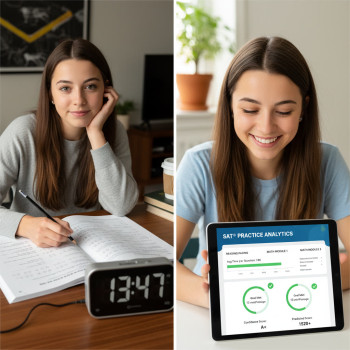Why digital note-taking is a game changer for Digital SAT study
Switching to the Digital SAT changed more than the way the test is delivered — it shifted how effective preparation looks. If you’re studying on a laptop, tablet, or school-managed Chromebook, it makes sense that your notes should live where you practice. Digital note-taking apps give you speed, structure, and searchability that paper can’t match. But more than that, they let you turn passive reading and practice tests into active, data-driven learning.
This post is for students who want practical, down‑to‑earth ways to use note apps (like Notion, OneNote, GoodNotes, Evernote, or simpler markdown apps) so every minute of prep counts. I’ll walk you through set-up, daily workflows, study-cycle examples, a sample template you can copy, and a short table showing how to use notes with different kinds of SAT content. I’ll also mention how Sparkl’s personalized tutoring can fit naturally into this workflow if you want 1‑on‑1 guidance or tailored study plans.
Set up your digital workspace the smart way
1. Choose one primary app and one secondary app
The worst friction in study systems is cognitive: “Where did I put that?” Pick one app to be your source of truth. This is where your study plan, question logs, and spaced‑repetition decks live. Use a second app only for quick captures (pictures of whiteboard work, screenshots from Bluebook, or handwriting on a tablet). Keeping the ecosystem small saves time.
2. Create a consistent folder and naming scheme
On day one, set up a handful of top‑level folders or pages: Study Plan, Practice Tests, Question Log, Vocabulary & Grammar, Math Notes, Essay & Rhetoric, and Review Decks. Inside each, use date‑first filenames or tags so you can sort chronologically. Example filename formats:
- 2025-09-01_PracticeTest3_Summary
- 2025-09-01_QuestionLog_Algebra
- 2025-09-01_Vocab_Week1
This makes it quick to find what you did on a given date and helps you measure progress over weeks.
Active strategies to make notes stick
1. Turn practice tests into teaching moments
After every full-length Bluebook practice test, don’t just glance at your score. Use your notes to do three things: identify patterns, explain mistakes in your own words, and set a micro‑goal for the next week.
- Pattern: “I missed question types with function translations in Algebra II.”
- Explanation: Write a short step‑by‑step solution in plain language, as if explaining to a friend who missed the concept.
- Micro‑goal: “Do 10 function translation problems and one timed math section this week.”
When you write explanations, type the problem, your wrong answer, then a corrected solution. This makes your future review more effective and creates a personalized bank of solutions you’ll actually understand.
2. Use active recall and spaced repetition
Digital note apps can be combined with SRS (spaced repetition systems). Convert every major concept or mistake into a flashcard-style note: a question side and an answer side. Schedule reviews into your calendar. Over time, your question log becomes a powerful, customized deck of high‑value flashcards.
3. Make the notes visual and scaffolded
For math, include annotated screenshots of your scratch work, graphs, and small step-by-step boxes. For Reading and Writing, annotate passages with color-coded highlights and margin notes that capture the author’s tone, purpose, and structural signals. The visual scaffolding helps your brain retrieve context, not just isolated facts.
Daily workflow — a simple loop you can actually do
Study systems fail when they’re complicated. Try a 3‑part daily loop: Preview → Practice → Reflect.
- Preview (10–15 minutes): Scan the target topic, set one measurable goal (e.g., finish 15 grammar questions, learn 8 words), and open the corresponding note page.
- Practice (30–90 minutes): Do focused practice (use Bluebook practice sections or targeted problem sets). Capture any errors or interesting examples into notes immediately.
- Reflect (10–20 minutes): Summarize what you learned, update your question log, and add flashcards for new concepts or tricky words.
Small, consistent gains beat sporadic marathon sessions. If you want accountability and tailored pacing, Sparkl’s personalized tutoring offers 1‑on‑1 guidance and can help turn these daily loops into a tailored study plan based on your diagnostic results.
How to structure your main note pages
Below is a notional template you can copy into your app. Make it modular so you can duplicate the page for any topic or practice test.
- Title: [Date] — [Resource/Practice Test] — [Section]
- Quick Summary: 2–3 sentences with your score or completion status.
- What went well: bullet list.
- Mistakes and why: numbered list with explanations.
- Action items: targeted practice for the next 7 days.
- Flashcards created: link or embedded list.
- Resources to revisit: chapter/page links, Bluebook timestamps, or screenshot references.
One table to rule them all — mapping content to note types
| Content Type | Note Style | Example Entry | Review Frequency |
|---|---|---|---|
| Math problem (Algebra) | Step-by-step solution + screenshot | “2025-09-01_Algebra_FuncTrans: show substitution steps” | Weekly (then monthly) |
| Writing & Language grammar rule | Rule summary + 3 example corrections | “Subject-verb agreement: tricky with collective nouns — examples” | Bi-weekly |
| Reading passage strategy | Annotation legend + passage summary | “Passage: Author tone = skeptical; evidence lines 12–18” | Weekly |
| Vocabulary | Flashcard (definition + sentence + synonym) | “ameliorate — to make better; sentence + synonym” | Daily review (SRS) |
Examples and mini case studies — how this helps in the real world
Example 1: Turning a recurring mistake into an advantage
Hannah kept missing circle geometry questions. In her math note page she wrote: “Common error: I skip drawing the radius and miss angle-chord relationships.” She started a simple checklist in the note: Always draw radii, mark equal segments, and write known angle properties. After two weeks, those geometry questions that used to trip her up became a quick five-point gain. That concrete checklist came directly from her notes.
Example 2: From passive highlight to active note
Marcus used to highlight entire paragraphs in practice passages and then feel no better about the author’s argument. He changed his method: after reading, he wrote a 20‑word summary and three evidence lines in a Reading Notes page. The next practice set, he could find author clues faster because his notes trained him to look for evidence lines rather than marking everything indiscriminately.
How to integrate screenshots, Bluebook practice, and device constraints
Because the Digital SAT uses the Bluebook testing app and many schools use Chromebooks or iPads, you’ll want workflows that fit your device. Two practical tips:
- Screenshot immediately after a practice question you miss. Paste it into a note with a caption: what type of mistake was it and what rule fixes it.
- If your device doesn’t allow easy screenshot paste, use a secondary app on your phone to capture and then sync to your main note app.
Practice the navigation of Bluebook alongside your study notes so that on test day the tools and muscle memory feel familiar. If device setup or Bluebook habit practice stresses you out, a few sessions with a Sparkl tutor can clear that friction: they can help you practice with the app, suggest device-ready workflows, and create an individualized study plan that fits your tech setup.
Checklist: What a week of digital note-taking looks like
- Sunday: Take a timed practice section or full test in Bluebook. Save screenshots of tricky questions to “Practice Tests” notes.
- Monday: Review the question log, write detailed solutions for mistakes, and create 10 new flashcards for SRS.
- Tuesday: Focused grammar and reading practice using annotation templates saved in your app.
- Wednesday: Math targeted practice (30–60 minutes), update math notes, and record one video note or voice memo explaining a complex solution (voice memos are great for teaching yourself).
- Thursday: Review SRS flashcards for 20 minutes and mark anything that still feels shaky for extra practice.
- Friday: Timed reading section, and add passage summaries to notes.
- Saturday: Lighter day — quick review of flashcards or a 30‑minute customized session with a tutor to focus on your stubborn question types.
Organizing vocabulary and grammar without the fluff
Vocabulary lists that sit unread won’t help. Here’s a lean approach:
- Pick 5–10 words per week tied to practice passages or official practice tests.
- For each word, create a mini card: definition (in your own words), 1 example sentence, 1 synonym, and an antonym if useful.
- Use those cards in SRS and put them into short daily review sessions rather than a long, one-off dump.
For grammar, keep a bank of 3–5 rules you’re actively working on. Revisit those rules after every writing set and summarize any new pattern you notice in your note page.
Collaboration and feedback — using notes with a tutor or study partner
Sharing a notes page with your tutor or study buddy multiplies its value. You can tag specific items you want help with — e.g., “Review #7: confusing tangent-chord theorem” — and the tutor can leave inline comments or short recorded explanations. If you work with a Sparkl tutor, for example, sharing your organized question log and study plan lets the tutor give laser-focused help, suggest edits to your notes, and provide AI‑driven insights that track what you’ve practiced most.
Common pitfalls and how to avoid them
- Over‑architecting your setup: If a system takes longer to maintain than to study, simplify. One clean notebook beats three half-updated ones.
- Highlighting without summarizing: Highlighting is the easiest way to feel productive without learning. Convert highlights to 15–30 word summaries.
- Neglecting review: Notes help only when you schedule spaced reviews. Set reminders or use an SRS tool integrated with your notes.
Tools and quick hacks that actually help
Every student’s toolkit will look a little different, but here are practical hacks that work on most devices and apps:
- Use searchable tags like #mistake, #vocab, #formula so you can pull up similar items quickly.
- Keep a “One-Minute Fix” section in each note with the smallest, fastest correction you can make to answer a type of question more correctly next time.
- Record short audio reflections after a practice session — speaking out loud helps you process mistakes differently than typing alone.
When to bring in personalized tutoring
Digital note-taking solves a lot, but sometimes you need human calibration. If you’ve been tracking errors for several weeks and notice you keep making the same types of mistakes, a few sessions of targeted tutoring can help you break the pattern more quickly. Personalized tutoring can also help you build a study plan that integrates your notes, suggests which practice tests to take when, and uses AI‑driven insights from your performance to prioritize topics. If you prefer structured check-ins, that 1‑on‑1 support can be a powerful complement to your note-driven routine.
Wrapping it up — the one-week experiment
Here’s a short experiment to test everything in this article. Try it for one week and measure the outcome:
- Day 1: Set up your main folders and copy the template page into your app.
- Day 2: Take a timed section in Bluebook and log every mistake into notes with a screenshot and explanation.
- Day 3–6: Use the daily loop (Preview → Practice → Reflect) and build SRS flashcards for new items.
- Day 7: Retake a similar practice section and compare speed, accuracy, and confidence. Note the difference in your notes.
Most students see improved clarity and fewer repeat mistakes simply by making their practice more deliberate. If you find yourself stuck or unsure how to prioritize, a short consult with a Sparkl tutor can map your notes into a focused plan and offer tailored, expert support.
Final thoughts — study smarter, not just harder
The Digital SAT rewards clarity and strategic thinking. Digital note-taking apps are more than digital notebooks — they’re rehearsal spaces for the kinds of quick, reliable thinking the test asks for. Use them to force clarity, break down mistakes into teachable steps, and build an evolving, personalized knowledge bank.
Your notes should do three jobs for you: remind you of what you’ve learned, make mistakes less likely to recur, and point you to the next most useful practice. If your notes aren’t doing all three, tweak your system and try again. Little improvements compound fast.
A short checklist to take away
- Pick a single source-of-truth note app and stick with it.
- After each practice test, write explanations for every mistake in plain language.
- Convert rules, common mistakes, and vocab into short, reviewable flashcards.
- Use screenshots and annotated steps for math problems.
- Review actively with SRS and a weekly reflection session.
- If you need faster progress or structure, consider short, targeted sessions with a Sparkl tutor to integrate notes into a tailored study plan.
Good luck — and remember: the goal isn’t to collect perfect notes; it’s to build a learning routine that turns practice into reliable performance on test day. Keep your system simple, review intentionally, and let your notes be the bridge between effort and results.















No Comments
Leave a comment Cancel